What Type of High Heels Are Bad for Your Health?
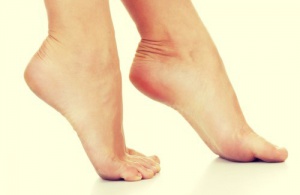

Reviewed and approved by the doctor Nelton Abdon Ramos Rojas
Yes, it’s true that they’re very pretty. However, this doesn’t mean that they aren’t bad for you. “Being fashionable and looking good is painful,” most women will say. But it isn’t necessary to suffer from bad shoes. In this article, we’ll help explain what shoe is best according to a woman’s activities and how much time you should wear high heels.
The worst shoes for women
A recent study by the New York Downtown Orthopaedic Associates states that the worst shoes that women can wear are those with high and skinny heels (known as stiletto heels in some places). This is because your body’s weight rests on the ball of your foot, where your toes are, which puts a lot of pressure on one point.
Also, your knees and hips roll forward and affect the body’s balance in general, which affects your legs and back. Wearing those kinds of shoes harms your ankles and your lower back area.
Did you know? 10 Habits that Cause Back Pain
Platform shoes, which are really popular nowadays, are also problematic. Many people will say that the weight is “split up” along the whole foot, but that’s not true. Just like stilettos, they put pressure on your toes, although having a thick heel protects your heels a bit more. Platform shoes produce calluses and bunions and cause ankle and back pain.
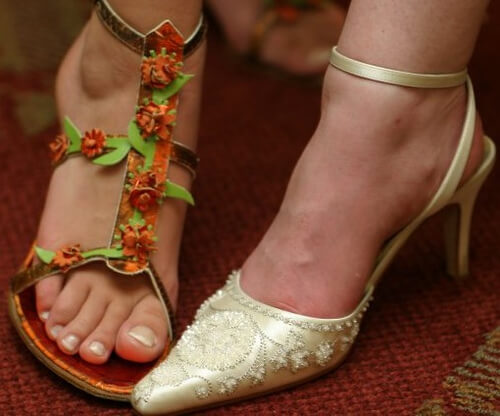
Ankle boots are a bit safer, but you can’t rely on them either. The study showed that 25% of the body’s weight that falls on your toes increases with the size of the heel. This means that the bigger the heel, the greater the damage will be.
Flats (or ballet slippers) are also very popular because you can wear them anywhere. But watch out! Due to the fact that they’re very flat and have no heel, they don’t give your foot good arch support, which makes it work double time. This causes inflammation, back or heel pain, or even fractures.
Lastly, tennis shoes support your feet the best. However, wearing them frequently can cause fungus, especially if you don’t wear cotton socks.
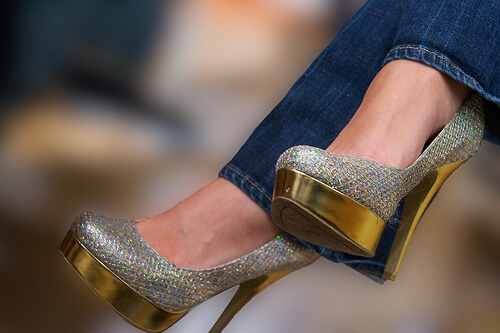
More information on wearing high heels
Statistics show that women suffer four times more foot problems than men. This is due to the shoes they wear, especially heels. When you put your bare feet on the ground, the front part (ball) supports 43% of your weight for every step and the heel absorbs the other 57%.
Discover: Pain Treatment for the Soles of the Feet
If your heel is 4cm high, this percentage changes places. When the heel is 6cm, the most pressure is on your toes (75%). When the heel is over 10cm, 90% of the weight rests on the ball.
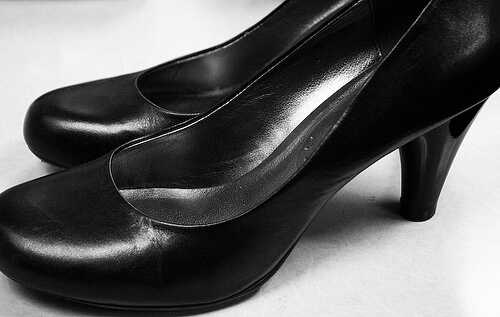
This imbalances your weight and makes you change your posture. The first joint that suffers from it is your ankles. This is why women are more likely to suffer from sprains if they wear heels. Since the lower part of the leg has to make up for the weight that was moved forward, it contracts and shortens, which causes discomfort and muscle contractions in your calves.
The knee is another joint that is overworked when you wear heels because the tension increases from the sole of the foot. You flex more than when you’re barefoot, which imbalances your quadriceps and the anterior leg muscle.
The list goes on and on: it misadjusts the hip joint, increasing lower back and back pain. Your whole posture changes. Bunions appear on your feet, as well as calluses and deformations on your toes. You may also suffer from swelling and pain after a full day wearing high heels.
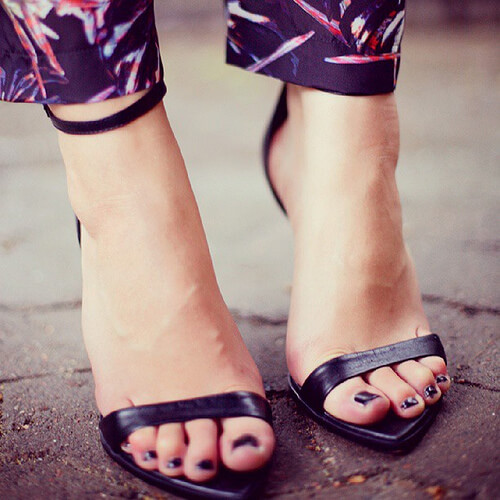
How to prevent problems related to wearing high heels
Now you know the risks of wearing high heeled shoes. However, if you still like them, just wear them to look prettier (they make your legs look more stylish, they’re perfect for parties, they make you look taller, etc.). Many people think that women should stop wearing them altogether. However, it’s not good to not wear any kind of heel, as we explained before.
You should only wear 2cm heels so that the support of your ball and heel bone is more balanced (50% for each part). They shouldn’t be higher than 3cm. If you like really high heels, go for platform shoes that don’t hurt your feet as much.
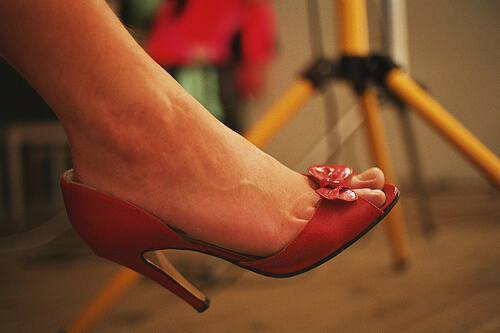
If you wear high heels once in a while for special occasions, you shouldn’t have any problems. What you shouldn’t do is wear them every day for hours on end.
If you can’t wear anything else at work, a good idea is to have another pair of shoes in your bag. Wear a more comfortable pair to walk to and from work and, when you get there, change into your heels. If you work behind a desk, you can also take them off and put them on when your boss comes in or when you need to go to meetings.
It’s also good to know that the more narrow the shoe, the less harmful it is. Regarding the material, the best kind is leather (synthetic, if possible). Your toes will be immobilized and won’t move “freely”.
Images courtesy of Mervi Eskelinen, Jocely Saurini, Larry Johnson, Heather Dow, Maria Morri, Thomas R. Koll, and Alison Here.
All cited sources were thoroughly reviewed by our team to ensure their quality, reliability, currency, and validity. The bibliography of this article was considered reliable and of academic or scientific accuracy.
- Barnish, M. S., & Barnish, J. (2016). High-heeled shoes and musculoskeletal injuries: A narrative systematic review. BMJ Open. https://doi.org/10.1136/bmjopen-2015-010053
- Martins Silva, A., Rocha de Siqueira, G., & Alves da Silva, G. P. (2013). Implications of high-heeled shoes on body posture of adolescents. Rev Paul Pediatr. https://doi.org/10.1590/S0103-05822013000200020
- Mika, A., Oleksy, L., Mika, P., Marchewka, A., & Clark, B. C. (2012). The effect of walking in high- and low-heeled shoes on erector spinae activity and pelvis kinematics during gait. American Journal of Physical Medicine and Rehabilitation. https://doi.org/10.1097/PHM.0b013e3182465e57
- Yung-Hui, L., & Wei-Hsien, H. (2005). Effects of shoe inserts and heel height on foot pressure, impact force, and perceived comfort during walking. Applied Ergonomics. https://doi.org/10.1016/j.apergo.2004.11.001
- Riesgos del uso de tacones – Clínica en Lugo | Clínica reactive. (2018). Retrieved 4 March 2020, from http://clinicareactive.com/tacones/
- Complicaciones asociadas a un mal calzado: tacones | CMUC. (2018). Retrieved 4 March 2020, from https://www.centroulcerascronicas.com/noticias/problemas-usar-tacones/
This text is provided for informational purposes only and does not replace consultation with a professional. If in doubt, consult your specialist.








